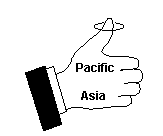Tuesday, May 14, 2013
Sunday, May 12, 2013
Why does the earth rotate
 The answer to ”why does the Earth rotate” leads down the dark path of physics. A murky place where few have willingly gone. The answer lies within the law of conservation of angular momentum. Angular momentum is the rotational counterpart of momentum.
The answer to ”why does the Earth rotate” leads down the dark path of physics. A murky place where few have willingly gone. The answer lies within the law of conservation of angular momentum. Angular momentum is the rotational counterpart of momentum.The angular momentum of an object is defined relative to a fixed point. In the case of astronomy the Sun is used as the fixed point.
The amount of angular momentum of an object with respect to a fixed point is proportional to the object’s moment of inertia and to the angular velocity relative to the fixed point. Multiplying those three factors gives the angular momentum. Angular velocity is defined by the right hand rule.(here is a link to a simple explanation of the right hand rule) The direction of angular momentum is the same as that of the angular velocity. The direction of momentum is the direction of the velocity. In the absence of torque both the amount and the direction of the angular momentum will not change. In the absence of a force both the amount and direction of momentum will not change.

When two objects with a particular angular moment relative to a common fixed point interact they affect each others angular momentum and the total angular momentum is conserved.
When you consider an orbit, the angular momentum is distributed between the spin of the planet itself and the angular momentum of its orbit, but, if a planet is found to spin more slowly than expected, astronomers suspect that the planet has a satellite, since the total angular momentum is shared between the planet and its satellite for the sake of conservation.
Some scientists believe that large impacts in the early history of the Solar System may have affected the rotation of some planets. One may have caused Venus to rotate in retrograde and another could account for the 23 degree axial tilt of the Earth.
The main reason that the Earth has never stopped rotating since the early periods of the solar nebula is that there is nothing in the vacuum of space to stop it. The only thing that may stop the Earth’s rotation is the gravitational forces of the Sun after it begins to expand into its red giant phase. Unfortunately, there will be no life on Earth to find out.

The earth rotates about an imaginary line that passes through the North and South Poles of the planet. This line is called the axis of rotation. Earth rotates about this axis once each day (approximately 24 hours). Although you most likely already knew that fact, there is a slight complication most people are not aware of.
More specifically, our rotation period (the time elapsed for one rotation) with respect to the stars is called a sidereal day. A sidereal day is 24 sidereal hours, or 23 hours and 56 minutes on a normal clock. Our clock time is based on the earth's rotation with respect to the sun from solar noon to solar noon. This is a solar day, and it is divided into 24 hours. Because Earth travels about 1 / 365 of the way around the sun during one day, there is a small difference between solar time.
So which way does the world turn? One way to visualize how the earth turns is to hold out your right fist with your thumb extended and pointing straight up (the traditional hitchhiker fist). If you visualize that your thumb points north, then your fingers are curling in the direction of Earth's rotation. Because of this easy set up, we say that the earth rotates in a "right-handed" manner (because you are using your right hand as a model).
 You can take this model a step further by visualizing that the base of your thumb is where Europe and Africa are located (Europe is above Africa of course when North is up).
You can take this model a step further by visualizing that the base of your thumb is where Europe and Africa are located (Europe is above Africa of course when North is up). The Atlantic Ocean would be on your fingers and the flat part of your fist by your knuckles are the Americas. The back of your hand is the Pacific Ocean, which leaves Asia to rest where your wrist is. If you keep this simple model in mind, you will always have an Earth-globe to check directions by. This is not so different from counting using your fingers.
Subscribe to:
Comments (Atom)